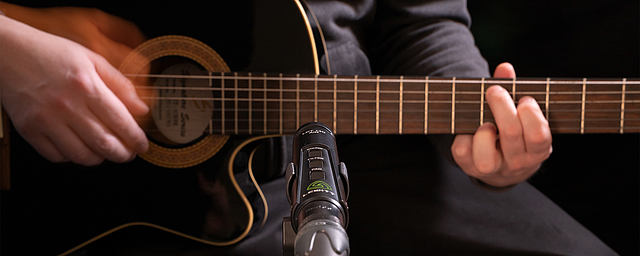
Blog
True love for great sound unites us.
Blog
True love for great sound unites us.
This article will cover which microphones are suitable for recording acoustic guitars and what else you need to start your musical journey.

Recording acoustic guitars is a broad field with different approaches. But the good news is that even with a simple setup, you can create outstanding recordings.
This article will cover which microphones are suitable for recording acoustic guitars and what else you need to start your musical journey. You can also watch a video we made below about how to get great results recording acoustic guitar in a home studio environment.
Acoustic guitars have a distinct and natural sound. You can use them in lots of different ways: there are nylon strings, there are steel strings – there is fingerpicking, there is playing with a pick, and various shapes or sizes guitars can have.
When it comes to choosing the right mic, you can follow three general approaches:
Small diaphragm condenser microphones are well-suited to capture the natural sound of your acoustic guitar.
A small mass diaphragm capsule has a superior transient response than dynamic capsules or large-diaphragm condenser capsules.
Transients define the characteristic sound of your instrument. They are a short, percussive sound with a high level at the beginning of a sound event - this behavior is what we call attack.
A typical small diaphragm condenser microphone for instrument recording usually looks like a pencil and is referred to as a "pencil mic".
A model from our range, the LCT 140 AIR.
If you have a dynamic microphone at home, try it - maybe you have a stage vocal mic of some sort.
Many great pieces in the history of guitar recording used an effortless setup with a single dynamic microphone and got legendary regardless.
From our experience, an acoustic guitar recorded with a single dynamic microphone works well if you already have a dense mix (e.g., with e-guitars) and you want to add more thickness to your track.
If you are looking for a new dynamic microphone, you might want to check out our MTP 440 DM or MTP 550 DM.
Some acoustic guitars have electric pickups. In these instances, you might be wondering why you even need a microphone if you can just plug your acoustic right into the DI input on your audio interface. There’s certainly nothing wrong with using a DI to record your acoustic guitar, and it can be a creative choice to do so. But in most cases it is best practice to use a microphone when possible.
Pickups are often located under the bridge or somewhere inside the body of the guitar in order to capture the vibrations of the strings. But they will not capture all the resonance and textures produced by the body of the guitar. The result will sound artificial and “plastic”, without the natural overtones from the body. To hear what we mean, check out the video below:
If you want acoustic guitars to have more presence in your mixes, recording in stereo is also a viable option. For stereo recordings, you can use all pencil (small diaphragm condenser) microphones. They often come as a dedicated stereo pair.
Here are the most basic setups for stereo recording.
If you're looking for a stereo pair with well-balanced sound, check out the LCT 040 MATCH stereo pair.
To achieve a balanced sound with a single mic, place it about 30 cm (12”) away from the guitar, pointing at the 12th fret, where the neck joins the body.
4 simple rules that will help you find a great sound.
![]()
Besides the microphone and your acoustic guitar, you need
Nowadays, we have excellent equipment that cost a fraction of the price people paid for studio equipment a decade ago.
In the end, what matters most is your song and the performance.

If you have any further questions, feel free to talk to us via e-mail, Twitter, Facebook, or Instagram. We’re happy to help! Make yourself heard.